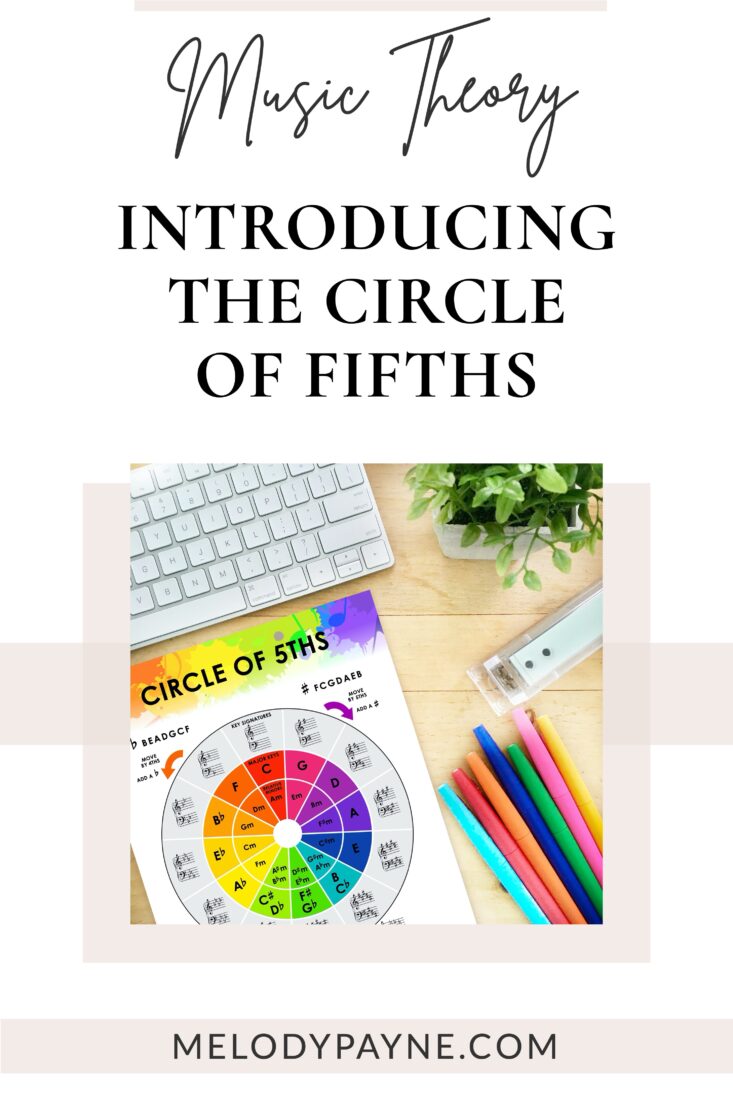Introducing the Circle of Fifths to Your Music Students
This post may contain affiliate links. If you purchase something through an affiliate link, I will receive a small commission at no cost to you. For more information, read the disclosure statement here.

Introduce your students to the circle of fifths in a vibrant and engaging way, and teach scales, key signatures, majors and relative minors, and more.
What is the circle of fifths?
The circle of fifths is an amazing tool to use when introducing students to key signatures, scales, and chords.
As soon as my students have mastered one or two octave scales and a few chords, I give them a copy of the circle of fifths and explain to them how it works (if you need help teaching scales and chords, check out Teaching Scales, Chords, And Arpeggios Using The Superstar Scales Piano Technique Book).
Of course their responses are varied, and can range from an excited response like “Wow, that’s so cool!” to a ho-hum-can-we-move-on-please “OK” 😁
But when I show them how it can HELP them memorize their scales and key signatures, the hesitant students are much more receptive to the idea of using the “rainbow circle with all the letters on it”.
How does the circle of fifths work?
The circle of fifths is a visual way to show the relationships between all 12 tones of the scale, including major & minor keys and their key signatures.
It has been used since the 17th century!
If you’re new to the idea of the circle of fifths, here’s a brief description that is very similar to how I introduce the circle to someone who is unfamiliar with it.
Sharp Keys
- The key signatures start at the top of the circle with no sharps or flats and move clockwise around the circle adding one sharp at a time (then removing a flat as you continue around the circle).
- If you start at the top with the key signature that has no sharps or flats, then look directly below that key signature, that’s the name of the major key: C Major.
- On the piano, if you start on C and go up 5 notes (counting C), that’s a 5th, and the top note is G. That’s also the next key on the circle: G.
- Add a sharp to the C major key signature, and you get the key signature for G major: 1 sharp, F-sharp.
- Next start on G and go up a 5th to D. That’s the next key around the circle. Add another sharp to the key signature, and you now have 2 sharps for the key of D Major.
- Keep moving clockwise by 5th and adding a sharp to the key signature each time.
Enharmonics
- Once you get to the bottom 3 keys, you’ve reached the enharmonics. The circle transitions from sharps to flats as you keep moving clockwise by 5ths: B = C-flat, F-sharp = G-flat, C-sharp = D-flat.
Flat Keys
- Keep moving clockwise by 5ths and as you go through the flats, take away a flat for each key as you move around the circle.
- Keep moving by 5ths until you’re back at 0 flats and you’ll be back to C major.
Minor Keys
- The inner wedges are the relative minor keys, which have the same key signature as the major keys of the same color.
- C major’s key signature has no sharps and no flats, so that means A minor’s key signature also has no sharps or flats.
- These two keys are related because they share a key signature, like you’re related to your (choose a family member) because you share a last name, so we call A minor the “relative minor” of C major.
Arrows
- The purple arrow reminds you that you can move clockwise by 5ths, adding a sharp as you go around, then removing a flat.
- The orange arrow shows that you can also move counterclockwise, and you’ll move up by 4ths instead of 5ths. So C to F is a 4th. F to B-flat is a 4th, B-flat to E-flat is a 4th.
- But moving clockwise by 5ths is the traditional way to use the circle.
Can I use the circle of fifths with chords?
Absolutely! Primary chords are so easy with the circle of fifths.
My students think it is super cool that if you choose a letter, C for example, the two letters on either side are the other two primary chords in the key of C: F and G.
Then my students realize that the primary chords in a key are all touching in the circle of fifths!
This makes it easy to work on chord progressions, lead sheets, and playing their favorite pop or praise & worship songs that might be too difficult to read directly from the score (this is great to help them use the AnyTune Pro App in Piano Lessons).
Knowing this simple trick helps them a ton when they’re trying to remember which chords are in a specific chord progression.
How does the circle of fifths help with key signatures?
The key signatures start with no sharps or flats, C major, and move clockwise adding one sharp at a time.
This is a great way to help students memorize key signatures as they learn the scales and chords in order.
Story Time
A LONG time ago in a galaxy far, far away… in my freshman college music theory class, our professor challenged us to be able to say all of the key signatures around the circle of fifths, in order, in only a few seconds:
C major: no sharps. G major: F-sharp. D major: F-sharp, C-sharp. A major: F-sharp, C-sharp, G-sharp…
He demonstrated exactly how fast we should be able to say them by striking a match and holding it sideways, and saying all of the key signatures before the flame reached his fingers!
Now that was fast! And extremely motivating to a bunch of college freshmen 🔥
Oh how we tried to say them quickly before the flame got too close!
Disclaimer: No fingers were burned in the learning of the key signatures.
Using the circle of fifths in piano lessons
First I’ll say that I’m NOT using them with matches! But a timer on my phone is the next best thing.
I’m using the circle of fifths with my piano students this semester as we focus on learning as many scales, chord progressions, and arpeggios as we can.
I introduce the scale, arpeggio, and chord progression in the same key to all of my students during the same week, and then everyone gets a new key the next week.
Of course everything is age-appropriate and level-appropriate, and tailored to the unique needs of each of my students.
Each week when I introduce a new scale to my students, I use the circle of fifths!
It helps them discover the key signature (the ones who are ready to learn about key signatures), see how far they’ve traveled around the circle, and see what’s coming up next.
Final words about the circle of fifths
So there it is! A quick and easy way to introduce the circle of fifths to your students, or to anyone who wants to know more.
Print the circle of fifths onto glossy photo paper to make a statement in your studio!
Or print onto white card stock, laminate, and enjoy for years to come.
Other blog posts to help you teach music theory:
Don't miss out!
Follow on Facebook and Instagram, join the best Facebook group for piano teachers, and subscribe to the newsletter to get helpful teaching tips, resources, and tutorials delivered straight to your inbox every week.
Melody Payne
Melody Payne
Welcome!

Hi! I’m Melody Payne, a pianist and piano teacher, educational resource author, a fun-loving wife to the most wonderful and talented hubby I could ask for, and a lifelong learner who loves to share. I want to make your life as a music teacher easier by writing and sharing helpful and relevant music teaching articles, and by creating educational resources with your very own students in mind. If you are a parent who wants to enroll your child in piano lessons, I’d love for us to get started building those skills that can give your child a lifetime of musical enjoyment!


This Post Has 4 Comments
Thanks for sharing that story of how you learned to quickly say all of the key signatures around the circle of fifths and their order of sharps & flats. What a motivating example!
It was so much fun to try to beat that match! Lots of times we just used a timer to be sure we were saying them quickly enough, and so we didn’t burn down the music building!
Great job on the circle of 5ths, the mirror of 5ths/4ths and it’s universal mnemonic device is an alternative to the circle of 5ths. this is a 4 row by 18 columns table that is a tabular representation of the circle of 5ths and can be used to teach students all about keys/scales, key signatures, chords etc in a very simplified way.
The circle of fifths is definitely an incredibly useful teaching tool for so many reasons!